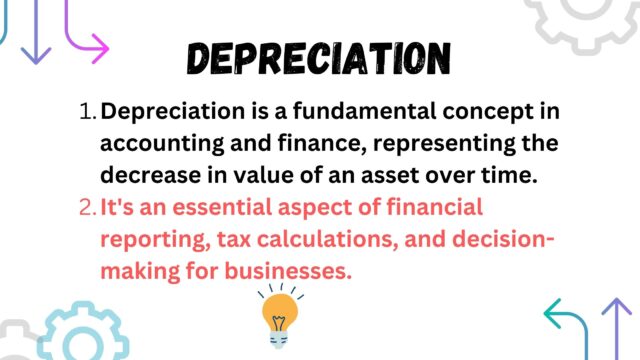Depreciation- Meaning, Definition, Types and Calculation [updated 2024]

Depreciation is a fundamental concept in accounting and finance, representing the decrease in value of an asset over time. It’s an essential aspect of financial reporting, tax calculations, and decision-making for businesses. In this comprehensive exploration of depreciation, we’ll delve into its definition, types, methods of calculation, significance, and implications.
Definition of Depreciation
Depreciation refers to the systematic allocation of the cost of tangible assets over their useful lives. Tangible assets include machinery, buildings, vehicles, and equipment—items that a company purchases for long-term use in its operations. Depreciation recognizes that these assets lose value as they are used, consumed, or become obsolete over time.
Methods of Calculation of Depreciation
Several types of depreciation methods exist, each reflecting different approaches to spreading the cost of an asset over its useful life. The choice of depreciation method depends on factors such as the nature of the asset, its expected pattern of use, regulatory requirements, and tax considerations. While straight-line depreciation is the most straightforward, other methods may better reflect the asset’s actual pattern of consumption or technological obsolescence.
- Straight-Line Depreciation: This is the simplest method, evenly spreading the cost of the asset over its useful life.
- The formula for straight-line depreciation is: [(Cost of Asset – Salvage Value) / Useful Life]
- Double Declining Balance (DDB): This method accelerates depreciation, reflecting the assumption that assets lose more value in the earlier years of their useful lives. It calculates depreciation by applying a fixed percentage (usually double the straight-line rate) to the remaining book value of the asset.
- Units of Production: This method ties depreciation to the actual usage of the asset. The depreciation expense is based on the number of units produced or the hours of operation.
- The formula is: [(Cost of Asset – Salvage Value) / Total Units of Production]
- Sum-of-the-Years’-Digits: This method also accelerates depreciation, but not as aggressively as the double declining balance method. It involves multiplying the depreciable cost by a fraction, where the numerator is the remaining useful life, and the denominator is the sum of the digits representing the asset’s useful life.
- MACRS (Modified Accelerated Cost Recovery System): Used for tax purposes in the United States, MACRS assigns assets to predetermined recovery periods and uses accelerated depreciation schedules to recover costs more quickly.
Significance of Depreciation
Depreciation plays several critical roles in financial accounting and decision-making:
- Accurate Financial Reporting: Depreciation ensures that a company’s financial statements accurately reflect the wear and tear of its assets over time. Without depreciation, assets would appear on the balance sheet at their historical cost, potentially overstating their value.
- Income Statement Impact: Depreciation affects the income statement by reducing net income. This reduction reflects the allocation of the asset’s cost to the periods in which it contributes to revenue generation.
- Tax Deductions: Depreciation expenses are tax-deductible, reducing a company’s taxable income and lowering its tax liability. The method used for tax purposes may differ from the one used for financial reporting.
- Asset Replacement Planning: By tracking depreciation, companies can anticipate when assets will reach the end of their useful lives and need replacement. This information is crucial for budgeting and capital expenditure planning.
- Asset Valuation: Depreciation impacts the valuation of assets on the balance sheet. As assets depreciate, their book value decreases. Understanding the remaining book value of assets is essential for assessing a company’s financial health and its ability to cover liabilities.
Implications of Depreciation
Understanding depreciation is vital for various stakeholders, including investors, creditors, managers, and regulators:
- Investors: Investors analyse depreciation to understand how efficiently a company manages its assets and generates profits. Higher depreciation expenses may indicate heavy investment in capital assets, while lower expenses could signal asset efficiency or impending obsolescence.
- Creditors: Creditors assess depreciation to evaluate a company’s ability to repay loans. Depreciation impacts cash flows, which in turn affects a company’s liquidity and creditworthiness.
- Managers: Managers use depreciation data for strategic decision-making, such as determining the optimal time for asset replacement or assessing the cost-effectiveness of capital investments.
- Regulators: Regulatory bodies require companies to adhere to specific depreciation methods and reporting standards to ensure transparency and comparability across industries.
Conclusion
Depreciation is a fundamental concept in accounting and finance, representing the systematic allocation of the cost of assets over their useful lives. It impacts financial reporting, tax calculations, and strategic decision-making for businesses.
By understanding the various types of depreciation, methods of calculation, and its significance, stakeholders can make informed assessments of a company’s financial health and performance. Depreciation ensures that financial statements accurately reflect the consumption of assets over time, facilitating transparency and accountability in corporate reporting.






